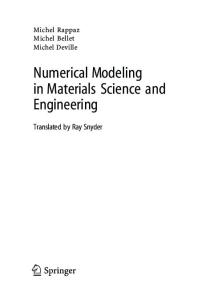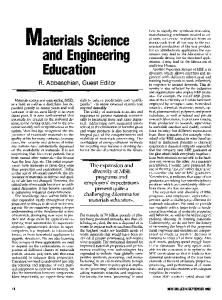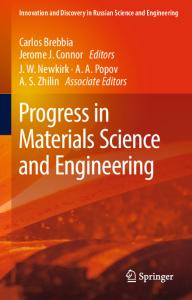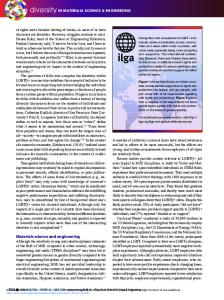Teaching sustainable development in materials science and engineering
- PDF / 640,806 Bytes
- 6 Pages / 585 x 783 pts Page_size
- 32 Downloads / 370 Views
Teaching sustainable development in materials science and engineering R. LeSar, K.C. Chen, and D. Apelian Preparing the next generation of materials scientists and engineers requires more than teaching them knowledge of material properties and behaviors. Materials science and engineering must also take into account materials sustainability in the context of society and the environment, as discussed throughout this issue. Including topics such as sustainability in a materials curriculum is not new. Issues of ethics, costs, and so on have long been an integral part of our education. Although detailed treatment of all such topics cannot be included in a general materials education curriculum, the concepts of sustainable development and the role of materials in a sustainable future can be introduced. Indeed, many materials science programs are beginning to include these topics in their curricula. This article discusses three such programs that the authors have helped design and implement in the United States, each taking a different approach to engaging students in these topics. The intention is not to provide an exhaustive overview of education in sustainable development, but rather to describe a range of strategies that are currently being applied and to raise pertinent issues in materials science education.
Introduction The challenges of sustainable development will require materials engineers and scientists to think beyond the current definition of what constitutes the “best” material for a given application. Increasingly, considerations of issues such as resources, toxicity, and life cycles will also be necessary. The question for engineering faculty is how to prepare students to meet these challenges. In this article, we describe some ways in which our separate institutions are currently teaching sustainable development to engineering students, especially materials scientists and engineers. Rather than providing a comprehensive review, we focus on three programs that can serve as examples of various pedagogical approaches. Before discussing these examples, however, we review some concepts that provide a basis for understanding sustainable development in a broader context. The first step in designing a curriculum in sustainable development is to agree on a common definition of what is meant by the term. As noted in the introductory article to this issue, the United Nations’ Brundtland Commission defined sustainable development as development that “meets the needs of the present without compromising the ability of future generations to meet their own needs.”1 Such a definition yields a broad and
flexible starting point for discussion. The advantage of a broad definition is that it does not restrict sustainable development to mean any specific technological or environmental topic but rather includes all current activities that could affect future generations. Thus, the definition can be refined accordingly for a specific course or project. In the most general sense, the goal of sustainable development is to create a sustainabl
Data Loading...











